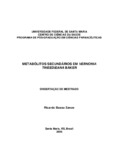| dc.creator | Zanon, Ricardo Basso | |
| dc.date.accessioned | 2006-08-14 | |
| dc.date.available | 2006-08-14 | |
| dc.date.issued | 2006-04-07 | |
| dc.identifier.citation | ZANON, Ricardo Basso. SECUNDARY METABOLIC OF VERNONIA TWEEDIEANA BAKER. 2006. 180 f. Dissertação (Mestrado em Farmacologia) - Universidade Federal de Santa Maria, Santa Maria, 2006. | por |
| dc.identifier.uri | http://repositorio.ufsm.br/handle/1/5948 | |
| dc.description.abstract | The species Vernonia tweedieana Baker is an herbaceous plant widely distributed in the
plains of Paraguai, Argentina and south of Brazil and popularly known as assa-peixe .
This plant is used in traditional medicine as an expectorant medicament. So far, this
plant was not studied on the phytochemical and biological point of view. This work is a
contribution to the phytochemical study of the Asteraceae. The leaves of V. tweedieana
Baker were collected in march of 2004, in Ijuí Rio Grande do Sul, Brazil, and identified
by Dr. Geraldo C. Coelho (UNIJUÍ). The respective voucher specimen was deposited in
the herbarium of the Federal University of Santa Maria (UFSM)-RS (code SMDB 9536).
The leaves (1.900 g) were dried in an air circulating stove at 40 ºC, pulverized in mill
and extracted by maceration with 65% EtOH at room temperature for seven days. The
ethanolic extract was filtered and the ethanol was removed. Finally, the extract was
retake in water and partitioned using organics solvents with increased polarity: CH2Cl2,
AcOEt and n-BuOH. We report the isolation and identification of six constituents of the
CH2Cl2 fraction: the triterpenes a-amyrin, b-amyrin and lupeol and the steroids b-
sitosterol, stigmasterol and spinasterol. The flavanone eriodictyoI was isolated from the
AcOEt fraction. The constituents were identified through spectral data of the infra-red,
GC-MS, 1H-NMR, 13C-NMR and DEPT. No deaths and other signs of toxicity and
adverse effect were observed in the evaluation of acute toxicity with doses up to 5.000
mg/kg, that is the maximum dose for acute oral toxicity test for extract of plants. Also,
through DPPH method, AcOEt and n-BuOH fractions of the plant showed good
antioxidant activity with IC50 22.52 and 17.44 mg/mL, respectively. | eng |
| dc.format | application/pdf | por |
| dc.language | por | por |
| dc.publisher | Universidade Federal de Santa Maria | por |
| dc.rights | Acesso Aberto | por |
| dc.subject | Vernonia tweedieana Baker | por |
| dc.subject | Triterpenos | por |
| dc.subject | Esteróides | por |
| dc.subject | A e b-amirina | por |
| dc.subject | Lupeol | por |
| dc.subject | B-sitosterol | por |
| dc.subject | Estigmasterol | por |
| dc.subject | Espinasterol | por |
| dc.subject | Eriodictiol | por |
| dc.subject | Triterpenes | eng |
| dc.subject | Steroids | eng |
| dc.subject | A-amyrin | eng |
| dc.subject | B-amyrin | eng |
| dc.subject | Lupeol | eng |
| dc.subject | B-sitosterol | eng |
| dc.subject | Stigmasterol | eng |
| dc.subject | Spinasterol | eng |
| dc.subject | Eriodictyol | eng |
| dc.subject | Acute toxicity | eng |
| dc.subject | Antioxidant activity | eng |
| dc.title | Metabólitos secundários em Vernonia tweedieana Baker | por |
| dc.title.alternative | Secundary metabolic of Vernonia tweedieana Baker | eng |
| dc.type | Dissertação | por |
| dc.description.resumo | O uso de plantas medicinais sempre teve uma importância vital no cotidiano da
humanidade. No entanto, apenas uma pequena parte destas já foram estudadas e
tiveram suas ações farmacológicas comprovadas cientificamente. Um exemplo de
planta ainda desconhecida quimicamente é Vernonia tweedieana Baker (Asteraceae),
vulgarmente conhecida como assa-peixe. É uma planta característica da região Sul do
Brasil que é usada popularmente para o tratamento de doenças respiratórias,
principalmente pelas suas propriedades expectorantes. Este trabalho descreve o
isolamento e identificação de seis constituintes químicos presentes no extrato CH2Cl2 e
de um no extrato AcOEt das folhas de Vernonia Tweedieana Baker. As folhas foram
coletadas em março de 2004, no município de Ijuí RS. A espécie foi localizada e
identificada pelo Prof. Dr. Geraldo C. Coelho (DeBQ-UNIJUÍ). Material testemunha
encontra-se depositado no Herbário do Departamento de Biologia da UFSM sob o
registro n° SMDB 9536. O material vegetal seco e moído (1.900 g) foi macerado
utilizando como solvente etanol:água (65:35, v/v). Após sete dias o extrato foi filtrado e
concentrado sob pressão reduzida para remover o etanol. Fez-se fracionamento desse
extrato bruto com solventes orgânicos de polaridades crescentes (CH2Cl2, AcOEt, n-
BuOH). Da fração CH2Cl2 caracterizou-se os triterpenos a e b-amirinas e lupeol, ainda
os esteróides b-sitosterol, estigmasterol e espinasterol; e da fração AcOEt o flavonóide
eriodictiol. Os compostos isolados foram analisados por CG-EM-IE, IV, RMN de 1H e
RMN de 13C e seus dados espectroscópicos foram comparados com os obtidos da
literatura. Ainda, na avaliação da toxicidade aguda foi verificado que nenhum dos
extratos apresentou toxicidade em doses até 5.000 mg/mL. Também, pelo método do
DPPH, foi constatada atividade antioxidante para as frações AcOEt e n-BuOH da
planta, apresentando IC50 de 22,52 e 17, 44 mg/mL, respectivamente. | por |
| dc.contributor.advisor1 | Athayde, Margareth Linde | |
| dc.contributor.advisor1Lattes | http://lattes.cnpq.br/7866111734540735 | por |
| dc.contributor.referee1 | Hoelzel, Solange Cristina da Silva Martins | |
| dc.contributor.referee1Lattes | http://lattes.cnpq.br/3371198135113385 | por |
| dc.contributor.referee2 | Mostardeiro, Marco Aurelio | |
| dc.contributor.referee2Lattes | http://lattes.cnpq.br/6195396264565980 | por |
| dc.creator.Lattes | http://lattes.cnpq.br/5822246772086708 | por |
| dc.publisher.country | BR | por |
| dc.publisher.department | Farmacologia | por |
| dc.publisher.initials | UFSM | por |
| dc.publisher.program | Programa de Pós-Graduação em Ciências Farmacêuticas | por |
| dc.subject.cnpq | CNPQ::CIENCIAS BIOLOGICAS::FARMACOLOGIA | por |


